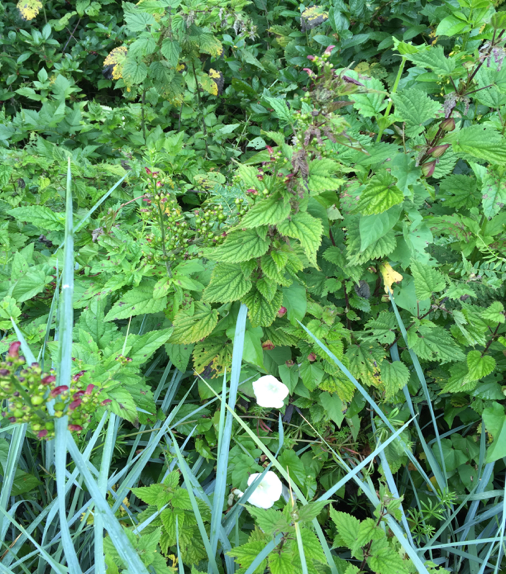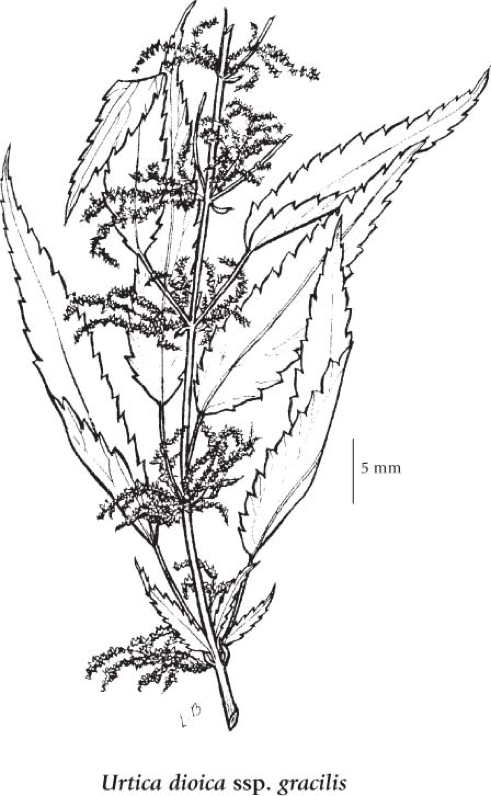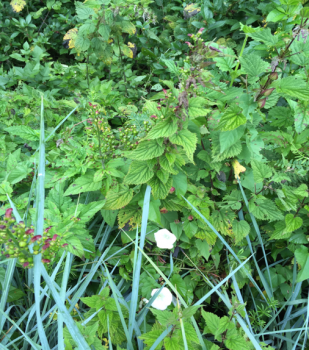Stinging Nettle (Urtica dioica)

Common Name(s): Stinging Nettle
Scientific Name(s): Urtica dioica
Island Hulkemel’em Name(s): th’uxhthuxh (Down and Up River)
Family: Urticaceae
Cautions: Stinging nettle defends itself through the use of miniature hypodermic needles containing acid in the stems. Stinging nettle, therefore typically causes skin irritation; however, it is not dangerous to animals or humans, but it will most certainly be unpleasant. Mitigation of skin irritation can be achieved through using a thick leaf from another plant species, such as dock leaves, for protecting your hands/skin.[1]
Botanical Description: Stinging nettle is perennial, typically flowering from June until August, standing roughly 30-250 cm tall. Stinging nettle’s reproduction is completed through the use of seeds, as well as underground rhizomes, also known as vegetative reproduction. The creeping rhizomes, which take root at the base, also produce shoots in the spring. Stinging nettle’s male and female flowers are found on separate plants. The roots of the stinging nettle are relatively strong and yellow in colour. The stinging nettle leaves are typically 4-15 cm long and quite easy to identify due to their oval shape, deeply toothed edges, and scattered surface with little hollow hairs (similar in structure to a hypodermic needle) that produce the ‘stinging’ effect of the nettle. In combination with these hairs, a reservoir of acid can be found at the swollen base of the leaves, ensuring the sting it delivers be felt. Stinging nettle’s flowers are usually small and white in colour, in a cone-like formation extending up to 10cm in length.[2]

Current Distribution and Local Habitat(s): Stinging nettle is a very resilient plant, allowing it to survive and even flourish in sites one would not expect; often leading to the misconception that it is a weed.[3] It has a very large range, finding itself on almost all continents, with native subspecies and sometimes introduced species. More specifically, stinging nettle flourishes when found in cool temperate regions with significant levels of sunlight. This being said it can survive in dry areas with slight shade.[4] It is commonly found in the understory of riparian communities. This species is typically found near water sources, open rich forests, meadows, and even disturbed sites (ie. Ditches, empty lots, etc.), due to the fact that these areas frequently contain nitrogen-rich soil, a favourable environment for stinging nettle.[5] On the University of Victoria campus, stinging nettle can be found in Finnerty Ravine, Haro Woods, and moist regions of the South woods. Overall, stinging nettle does especially well in sites characterised by damp soil, rich in nutrients. Areas that fall under this type of criteria are as follows: woods, unmanaged grasslands, waste ground, gardens, farmland, and river banks.[6]
Ethnobotanical Application(s): Stinging nettle has been used in many different ways throughout the course of history by First Nations. Nettle can be used as a food, if cooked, the ‘stinging’ disappears and it can be added to culinary dishes as well as eaten in a similar way to spinach. Above ground parts of the plant have been used in the past for internal bleeding, UTIs, urinary issues due to enlarged prostate (root), muscle aches and pains, and hair and skin issues. Another very important and common use of the stinging nettle was the extraction of the valuable fibres within the plant’s stem. Dry nettle is picked in late summer or early fall, ensuring it is fully dry. It is then worked with gently to remove the hard outer bark, once this is down the same is done with the softer inner bark, leaving you with the nettle fibres. The fibres were typically used to make cordage for ropes, nets, or even for making clothing as it is strong and won't shrink drastically.[7]
UVic Campus Location(s): Stinging nettle can be found in multiple different areas on campus, most notably: in the moist regions of South Woods, Finnerty Ravine, as well as Haro Woods.
Figure Reference(s):
Figure 1: Personal Photo, by Conrad Parken, June 2016.
Figure 2: Douglas, G. W., Meidinger, D. V., & Pojar, J. (1999). Illustrated flora of British Columbia. Victoria, B.C.: British Columbia Ministry of Environment, Lands and Park
[1] Bavaria.army (2016). Nettle. Retrieved 23 June 2016, from http://www.bavaria.army.mil/docs/Environmental_Nettle.pdf
[2] Ibid.
[3] Homolka, K. (2011, April). Where Nettles Can be Found. Retrieved June 15, 2016, from http://bioweb.uwlax.edu/bio203/2011/homolka_kail/habitat.htm
[4] The Stinging Nettle Urtica dioica. (2004). Retrieved June 16, 2016, from http://depts.washington.edu/propplnt/Plants/Urtica dioica.htm
[5] Homolka, K. (2011, April). Where Nettles Can be Found. Retrieved June 15, 2016, from http://bioweb.uwlax.edu/bio203/2011/homolka_kail/habitat.htm
[6] Bavaria.army (2016). Nettle. Retrieved 23 June 2016, from http://www.bavaria.army.mil/docs/Environmental_Nettle.pdf
[7] Bavaria.army (2016). Nettle. Retrieved 23 June 2016, from http://www.bavaria.army.mil/docs/Environmental_Nettle.pdf
Project Status:
Date Completed:
Year:
Associated Projects:
Image:

